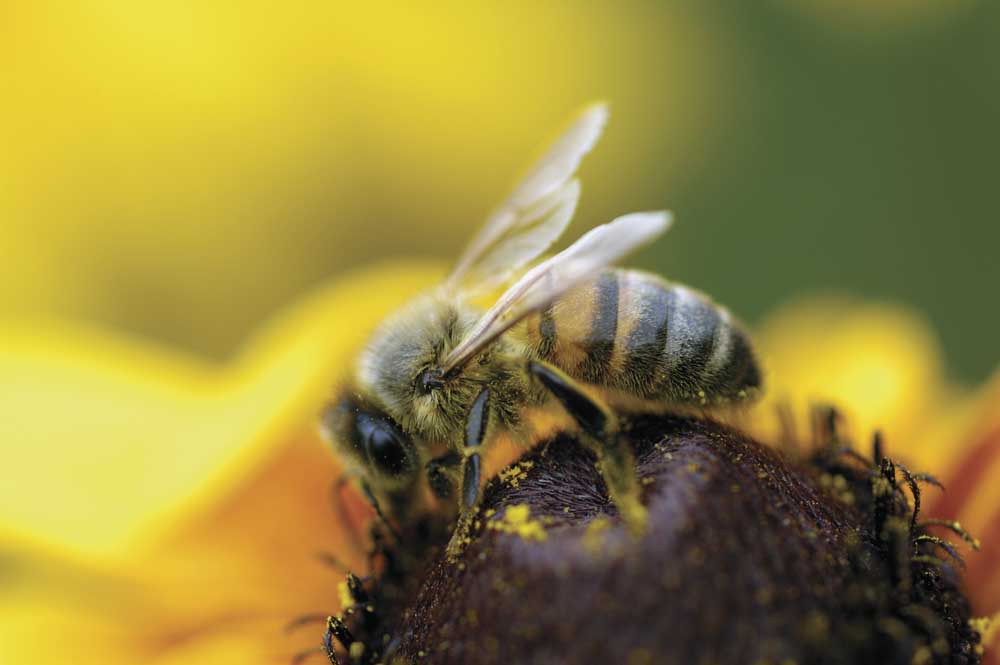Benefits of Bees
Published 1:08 pm Tuesday, July 2, 2019

- Bees and other insects play an important role in agricultural production.
Central Oregon gardeners and farmers love to be buzzed when standing in their fields and farms. Not a microbrew related buzz, but the sound of bees flying amongst their flowers and crops while providing the growers with an important service: pollination.
In case you never got the “Birds and the Bees talk,” pollination is the process when pollen grains from a flower’s male part (the anthers) are transferred to another flower’s female part (the stigma) of the same species. There the pollen grain grows a long tube down the flower’s ovary where fertilization occurs. The U.S. Fish and Wildlife Service estimates that nearly 75 percent of all the earth’s flowering plants depend upon pollinators in order for the plant to set seed or fruit. Out of this group of plants, about one-third are crops that produce food such as blueberries, apples, oranges, squash, tomatoes and almonds.
“Pollinators and insects are very important to the success of our farm,” said Sarahlee Lawrence, owner of Rainshadow Organics located in Terrebonne and a member of the High Desert Food & Farm Alliance (HDFFA). “Not only do they pollinate our crop plants like tomatoes, eggplants, peas and cucumbers, but some help manage insect pests like aphids.”
Many farms rely on domesticated honey bees to manage the heavy load of pollinating flowers. To provide sufficient food resources for her bees, Lawrence selectively thinned junipers from 57 acres of her 200 acre farm, and then replanted that acreage with grasses, wildflowers and native shrubs to provide food for her bees, but also to attract other native pollinators.
“It takes about one acre of plants to support a single hive,” added Lawrence.
In addition to honey bees, wild native bees, beetles, hummingbirds, flies and even moths pollinate vegetable or crop plants. Attracting these pollinators and providing sufficient habitat resources for them is critical to a farm or garden’s success.
“The more diversity in the planting, the more diverse the pollinator community,” said Amy Jo Detweiler, associate professor at the Oregon State University Extension Service. “Select native plants to attract native pollinators and be patient in waiting for pollinator communities to build up.” Detweiler also recommends grouping plants of similar colors or types in clumps so that it is easier for a pollinator to visit plants rather than having to fly all around to locate another pollen-producing plant.
Timing is also important in attracting these pollinators. Growers such as Lawrence and Jennifer Ladd, owner of Sweet Posy in Bend and HDFFA members, sow annual and perennial wildflowers that bloom throughout the growing season, providing pollinators with a continuous succession of flowers.
“In addition to a buffer area around our flower beds, we grow annual and perennial wildflowers in a fenced sanctuary zone that is protected from our pasture animals,” said Ladd. Growing heirloom specialty cut flowers on two acres, her pollinators are very important to her farm.
“We collect seeds from many varieties of our flowers in the fall and store these for next season,” said Ladd. Without the pollinators, the flowers would not set seeds and that important resource would be lost.
In order to protect their insect pollinators, growers such as Lawrence and Ladd don’t use pesticides to control insect outbreaks. Instead, they rely on prevention, vigilance and soil fertility to grow strong plants that can withstand harmful insects. But if an outbreak occurs, there are biological controls that can be employed.
“Three beneficial insects that we have in Central Oregon includes parasitic wasps, ladybugs and lacewings,” said Detweiler. “Lacewing and ladybug larvae feed on soft-bodied insects that can cause plant damage, while parasitic wasps parasitize several different harmful insects including aphids.”
In a backyard garden, sap-sucking insects such as aphids or leafhoppers may be removed manually (i.e. squished) or sprayed with a soapy water mixture if no beneficial insects are around. Caution is advised when ramping up a response to an insect infestation that involves pesticide use. Even the unintentional misuse of a pesticide can do a lot of damage to the pollinator community. Contact the OSU Extension Service for help identifying insects and determining a course of action.
“The first step in effective management is to make sure they have properly identified the pest,” said Detweiler. “For many crops that depend on pollination for fertilization, it is essential that we create a healthy and welcoming environment for all pollinators.”
So the next time you’re out in the garden getting “buzzed,” give praise to these insects for their pollination services and for helping control unwanted insects.








